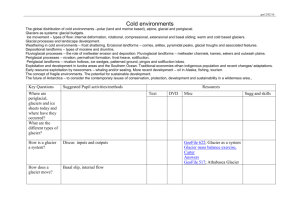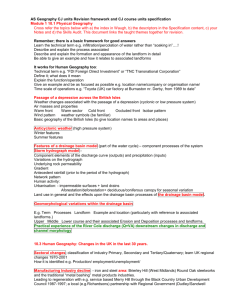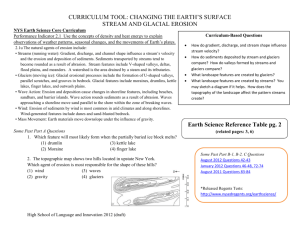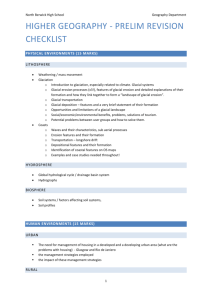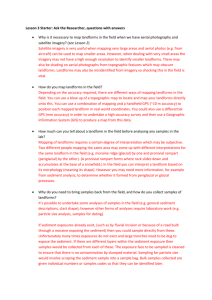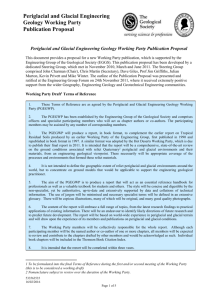Cold Environments Exam Questions
advertisement
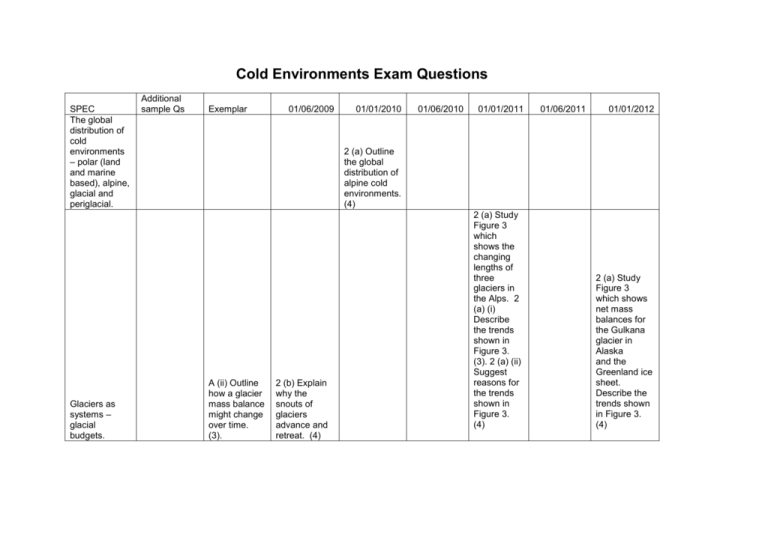
Cold Environments Exam Questions SPEC The global distribution of cold environments – polar (land and marine based), alpine, glacial and periglacial. Glaciers as systems – glacial budgets. Additional sample Qs Exemplar 01/06/2009 01/01/2010 01/06/2010 01/01/2011 01/06/2011 01/01/2012 2 (a) Outline the global distribution of alpine cold environments. (4) A (ii) Outline how a glacier mass balance might change over time. (3). 2 (b) Explain why the snouts of glaciers advance and retreat. (4) 2 (a) Study Figure 3 which shows the changing lengths of three glaciers in the Alps. 2 (a) (i) Describe the trends shown in Figure 3. (3). 2 (a) (ii) Suggest reasons for the trends shown in Figure 3. (4) 2 (a) Study Figure 3 which shows net mass balances for the Gulkana glacier in Alaska and the Greenland ice sheet. Describe the trends shown in Figure 3. (4) Ice movement – types of flow: internal deformation, rotational, compressional, extensional and basal sliding; warm and cold based glaciers. Glacial processes and landscape development. Weathering in cold environments – frost shattering. Erosional landforms – corries, arêtes, pyramidal peaks, glacial (b) (i) Distinguish between warm and cold-based glaciers. (4) Outline the process of frost shattering and outline how this process might contribute to glacial erosion. (4) Study the photograph. What evidence is there that 2 (b) (i) With reference to Figures 4a and 4b, distinguish between warm based and cold based glaciers. (3). 2 (b) (ii) With the help of Figures 4a and 4b, explain how ice moves by basal sliding. (5) 2 (a) Describe the pattern of ice movement shown in Figure 3. (4) 2 (b) Study Figure 4 which shows two types of ice movement. 2 (b) (i) Identify the types of movement shown at X and Y. (2) 2 (b) (ii) Define the term 'internal deformation'. (2) 02 (b) Outline the process of frost shattering. 01 (b) Explain why a river valley changes in its cross profile downstream. (7) 2 (c) Describe the characteristics of drumlins and suggest 2 (b) (i) Describe the landforms resulting from glacial 2 (a) (i) Describe the types of moraine shown in troughs and associated features. Depositional landforms – types of moraine and drumlins. Fluvioglacial processes – the role of meltwater erosion and deposition. Fluvioglacial landforms – meltwater channels, kames, eskers and outwash plains. Periglacial processes – nivation, permafrost formation, frost heave, solifluction. Periglacial landforms – nivation suggests that this landscape has been affected by glacial erosion? (7) reasons for their formation. (7) erosion shown in Figure 3. (4). 2 (b) (ii) Choose one of the landforms of glacial erosion shown in Figure 3. Name the landform and explain its formation. (7) Zone A of Figure 2. (4) 2 (a) (ii) Explain the origin of the moraine shown in Zone A of Figure 2. (4) 2 (c) Assess the role of meltwater erosion and deposition in the formation of fluvioglacial landforms. (15) Suggest how solifluction lobes form in periglacial environments. (4) B (ii) Explain the formation of patterned ground in periglacial environments. (7) 2 (a) Define the term ‘periglacial’. (2). 02 (c) Explain the annual changes in the active layer above the 2 (b) (i) Define the term ‘periglacial’. (2) 2 (b) (ii) Outline periglacial processes likely to be occurring 2 (c) Draw a labelled sketch to show characteristics of a pingo and suggest an explanation for its formation. (7) hollows, ice wedges, patterned ground, pingos and solifluction lobes. Exploitation and development in tundra areas and the Southern Ocean. Traditional economies of an indigenous population and recent changes/ adaptations. Early resource exploitation by newcomers – whaling and/or sealing. More recent development – oil in Alaska, fishing, tourism. The concept of fragile environments. The potential permafrost. (4). 02 (d) Describe the patterned ground shown in Figure 2 and explain its formation. (6) There are many pressures on tundra regions in the northern hemisphere caused by the desire of people to develop the regions. Describe these pressures and discuss whether these regions could be developed in a sustainable way. (15) 2 (d) To what extent do you agree that development in tundra areas and/or the Southern Ocean has become more sustainable? (15) 2 (c) Using Figure 4 and your own knowledge, explain why many cold environments are fragile and how they can be cared for to ensure sustainability. (15) around the glacier in Figure 2. (5) 01 (a) (ii) Study Figure 1 which shows the predicted return period of flood events for the River Ouse at York. Summarise the information shown in Figure 1. 3 2 (c) To what extent is there conflict between development and sustainability in tundra areas? (15) 2 (d) To what extent are more recent developments in cold environments (such as oil, fishing and tourism) sustainable? (15) for sustainable development. The future of Antarctica – to consider the contemporary issues of conservation, protection, development and sustainability in a wilderness area. (c) Why should Antarctica be protected from development? (15) 02 (e) Discuss how a balance may be found between protection and development in Antarctica. (15)

